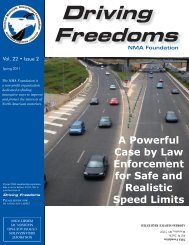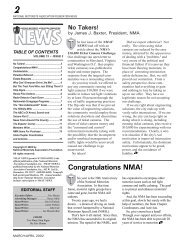A Covert War Against Drinking - American Beverage Institute
A Covert War Against Drinking - American Beverage Institute
A Covert War Against Drinking - American Beverage Institute
You also want an ePaper? Increase the reach of your titles
YUMPU automatically turns print PDFs into web optimized ePapers that Google loves.
Endnotes1 “Some People Question Further Need forOrganization,” The Columbus Dispatch, 12January 2003.2 U.S. Department of Transportation, NationalHighway Traffic Safety Administration, TrafficSafety Facts 2000, DOT HS 809 337, April 2002,32; and National Highway Traffic SafetyAdministration, Traffic Safety Facts 2001, DOTHS 809 470, December 2002, 1.3 “Really MADD: Looking Back at 20 Years,”DRIVEN, Spring 2000.4 “MADD’s Mission is to Save Lives,” ChicagoTribune, 18 February 1997.5 “Drunken Driving Laws ’98: States Face Debateon Legal Limit,” USA Today, 2 January 1998.6 Karolyn Nunnallee, Today Show, 12 October 1996.7 MADD Fundraising Letter, December 2002.8 “No Drunks Need to Drive,” St. Louis Post-Dispatch, 12 September 2002.9 Unpublished analysis of U.S. Department ofTransportation Fatality Analysis ReportingSystem data on BAC levels and fatalities inaccidents where a driver was actually tested.10 According to NHTSA’s BAC Estimator (developedin October 1994), a 160-pound man withan average metabolism who drank 9.5 drinksin a four-hour time period without food wouldreach 0.16% BAC (A drink is defined by theprogram as containing 0.54 ounces of alcohol.).11 Analysis of U.S. Department of TransportationFatality Analysis Reporting System data.Calculation includes traffic fatalities in which adriver involved was actually tested at 0.01%BAC or above. All deaths were categorizedaccording to the highest BAC of a driver byindividual crash.12 Boston University School of Public Health biographyof Ralph Hingson, http://www.bumc.bu.edu/sph/FacultyStaff/FacultyDetail.asp?PeopleID=625; accessed 1 March 2003.13 Robert Scopatz, “Analysis of 1975-1993 FatalCrash Experience in states with 0.08% LegalBlood Alcohol Levels,” <strong>American</strong> <strong>Beverage</strong><strong>Institute</strong>, Executive Summary, May 1997.14 Ibid., 12.15 Robert Voas et al., Effectiveness of the Illinois .08Law, Pacific <strong>Institute</strong> for Research andEvaluation for National Highway Traffic SafetyAdministration, September 2000.16 “Researcher Examines ‘Real World’ Effects ofAlcohol Prevention,” Food & Drink Daily 5, no.85 (5 May 1995).17 James Fell and Delmas Johnson, “The Impact ofLowering the Illegal BAC Limit to .08 in FiveStates in the U.S.,” 39 th Annual Proceedings ofthe Association for the Advancement ofAutomotive Medicine, Chicago, IL (1995), 45-63.18 “Highway Safety: Effectiveness of State .08Blood Alcohol Laws”, General AccountingOffice Report to Congressional Committees,GAO/RCED-99-179, June 1999, 21.19 Ibid., 14.20 Hearing of the Transportation andInfrastructure Subcommittee of the SenateEnvironment and Public Works Committee onthe Surface Transportation Act Renewal,Testimony of Mr. Phillip R. Recht DeputyAdministrator for the National HighwayTraffic and Safety Administration, 7 May 1997.21 GAO Report, Highway Safety, 16.22 Ibid.23 Ibid.16<strong>American</strong> <strong>Beverage</strong> Licensees | America's Beer, Wine, and Spirits Retailers






